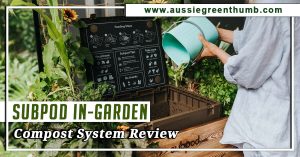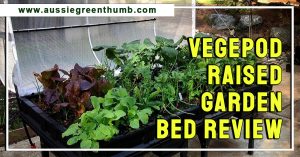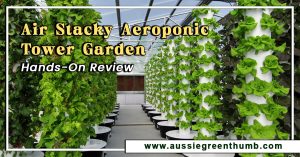There is nothing more impactful in a garden than water. Whether it’s a swimming pool and fish pond, or a simple garden pond, bringing water into your garden creates a calm focal point for your entire gardening year to revolve around.
We’re unashamedly pro-pond at Aussie Green Thumb, so as well as talking through the benefits of garden ponds, and how to build your own, we’ve got quick links to the best garden pond installers in Australia, and the best garden pond kits to buy online now. So there’s no excuse, get out there and build a pond!
More...
Top Pick

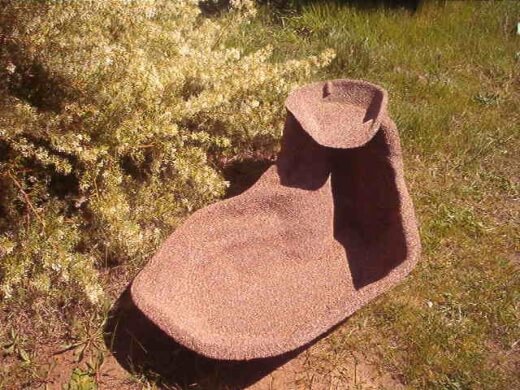
Best Value

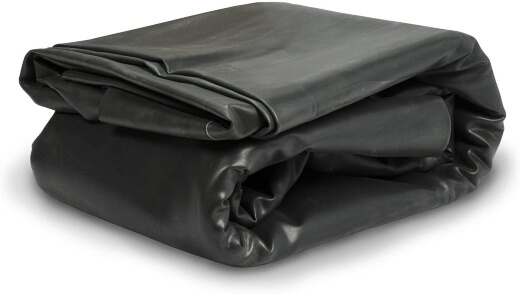
Premium Choice


Best Garden Ponds Ratings Chart
Product | Our Rating | Price | |
|---|---|---|---|
1. Erskine Falls Natural Garden Pond |  |  | |
2. Lake Natural Garden Pond |  |  | |
3. Aquascape PRO Grade EPDM Boxed Pond Liner |  |  | |
4. Aquapro 113L Coquetdale Preformed Poly Pond |  | ||
5. Lonsdale Natural Garden Pond |  | ||
6. Aquascape AquaGarden Pond and Waterfall Kit |  | ||
7. Aquapro 1200 Rectangular Feature Poly Pond |  | ||
8. Aquapro 910 Round Feature Poly Pond |  | ||
9. Aquapro 100L Small Rock Look Pond |  | ||
10. Hygger 500D PVC Soft Rubber Pond Liner |  |
Garden Pond Building Guide
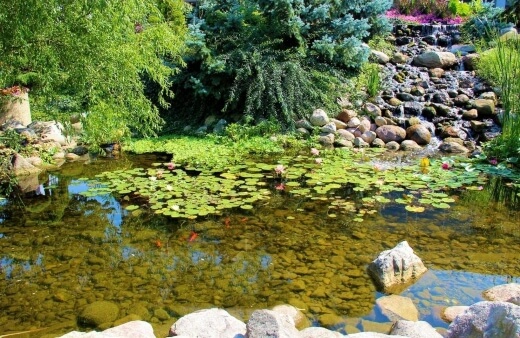
Why Build a Garden Pond?
I’ve always had this dream of building a garden which was entirely pond, with stepping stones to reach islands, and clumps of bog plants, filtering into shallow pond border plants, with fish, and hundreds of oxygenating pond plants creating a carpet of floating foliage.
Most gardeners don’t share that dream and tell me I’m losing my marbles, but they will all agree that a pond is the best feature you can add to your garden.
I could write for weeks about the benefits of garden ponds, but to be brief, these are the best reason to build a garden pond:
- Garden ponds bring wildlife
- Improve the air
- Reduce noise pollution
- Encourage beneficial predators to protect your plants
- Look incredible
- Open up a new world of plants for the garden
- Reduce stress
Even the smallest garden pond will change your entire relationship with the garden for the better, so follow our buyer’s guide below to tips on how to choose the best garden pond, and what kind of outdoor pond is going to suit you, your family, and your garden.
What to Look for When Starting a Garden Pond
There’s no definitive guide to buying garden ponds. Every garden is different, and more importantly, every gardener is different, and even readymade kits are just a starting point for a new adventure in water gardening.
We’re going to use this buyer’s guide to garden ponds to help you decide on the best type of pond for you. That might be the best fish pond on the market, or it might mean getting the spade out and buying a 30m pond liner for a gigantic wildlife pond.
Different Types of Garden Pond

I’m a wildlife gardener, so I always prefer ponds that bring life into the garden. For me, that means keeping it as natural as possible, but what’s really important to note is that all garden ponds bring wildlife into the garden.
There are some types of ponds that are better for wildlife than others, but any pond will encourage birds to drink and bathe, and the range of Australian native pond plants you can include in fish ponds is brilliant for pollinators. Even above-ground water features make great birdbaths.
Fish ponds
Fish ponds are high maintenance, but there’s nothing that compares to the joy of keeping and feeding healthy fish. Fish ponds need to be regularly cleaned, with effective filters, or at least 75% surface coverage of oxygenating plants.
That makes them harder to maintain, but compared to the rest of the garden is less effort than keeping a pristine border full of flowering perennials.
While most people think of koi carp for garden ponds there are loads of alternative fish to koi for ponds.
The best fish for garden ponds:
- Koi (beautiful, but check state laws)
- Goldfish (large breeds are a good alternative to koi)
- Plecos (actively clean ponds of excess algae)
- Trout (easy to keep, but need running water and deep pools)
- Rainbowfish (native, and easy to keep in well oxygenate ponds in warm northern states)
- Smelt (native, and won’t eat tadpoles, so great for wildlife ponds)
- Empire gudgeon (eats tadpoles, so useful if you don’t want frogs in the garden, or to protect other fish)
- Australian bass (great for larger ponds with running water)
Note: NSW, ACT and WA are the only states that allow pond owners to keep koi.
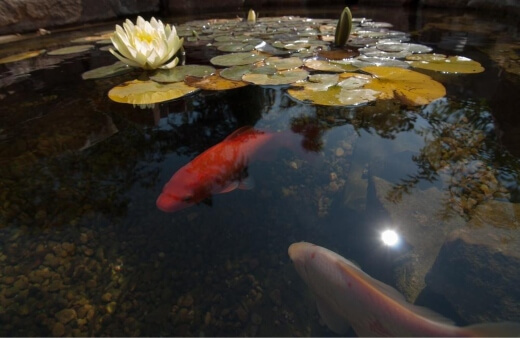
Wildlife ponds
Fauna
Wildlife ponds are the easiest ponds to install and maintain. They encourage native wildlife into the garden, including frogs and newts.
Newts and toads are unusual in Australia, so if you spot native species like spadefoot toads or the common newt, it’s well worth installing a wildlife pond to support their habitat.
Even without amphibians, garden ponds create a brilliant space for dragonflies, hoverflies and caddisfly, who all lay their eggs in the shallows or on reeds, and larvae develop over months (years in some cases) to pollinate your garden and eat pests like aphids and thrips.
Flora
If you prefer to keep a creature free garden, wildlife gardens are probably not right for you, but they provide excellent habitat for native plants too.
Most pond plants are prehistoric, so are actively native to the entire world rather than just Australia, but some like Swamp Stonefoot, Azolla, or Native peppermint are unique to this continent.
Native pond plants provide food for pollinators and can flower earlier in the year when there are few other flowers in the garden.
Above Ground Water Features
Raised water features are brilliant for gardeners with little time, or limited space to be able to maintain a full-sized pond, but can still be a great space for native pond plants, or just to introduce the sound of flowing water into a garden.
Water features like this can include pumps and fountains, or provide contemplative still water depending on your taste, but the sound of moving water, and its ability to clean and improve the air quality in your garden is unrivalled.
You can have it all…
While there are loads of ponds on the market that are sold as either a fish pond, wildlife pond, or swimming pool, there’s no reason you can’t have it all.
A friend recently had their old outdoor pool converted into a usable fish pond, full of oxygenating plants. The pond plants combined with the best pond filters make it ideal for swimming as the water is crisp and clear.
To achieve something like that costs a few extra dollars, but can be worth it for the immense wow factor of a swimming pond!
How to Install a Garden Pond
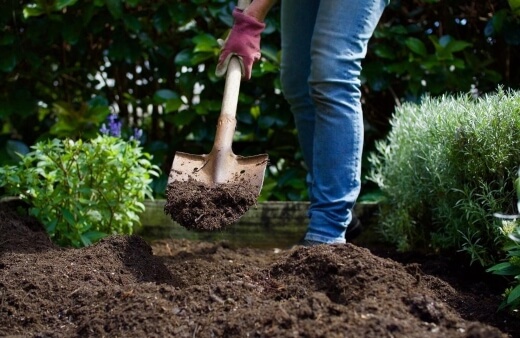
If you just want still water, or a basic water feature, installing a pond is surprisingly simple. As long as your pond is the right depth and holds water, you’re good to go.
But, there are a few basic considerations for installing a garden pond before you get started:
- Choose the right depth. Garden ponds for wildlife need multiple levels, with 1-2m deep sections for wildlife in summer and shallow slopes so creatures can get out easily. Fish ponds need similar depths to protect them from summer heat too.
- Choose between filters and pond plants. Moving water, like waterfalls, improves aeration, but filters are the best option for keeping fish clean. Pond plants like water lilies help reduce algae by oxygenating water too.
- How to make a pond watertight. You can use pond liners, either solid pond structures, or pond liner sheets will work fine, but you can also dig down, and build concrete walls which can be waterproofed. These can look much neater and will last 20-30 years.
If you don’t fancy installing a garden pond yourself, or need more complicated plumbing and electrics for your garden pond, we’ve got a list of the best garden pond installers in this article so you can find the best pond installers near you.
Installing a Pond Liner
Pond liners usually come with a 30-year warranty, but they have to be installed correctly. To install a pond liner:
- Dig your pond out, and remove any sharp stone or rubble.
- Pack the base and walls of the pond with sand to create a smooth base.
- Roll out your liner and push it carefully into the hole (do NOT cut it yet).
- Fill the liner with water, allowing it to sink into the hole and push into all the nooks and crannies.
- As the pond liner fills, fix creases by flattening them or pushing air bubbles around the outside.
- Once your pond is full, trim the edge of the liner, leaving at least 50cm excess.
- Bury the excess liner under edging stones, or turf to hide the liner.
Pond Filter Installation
There are a lot of different types of pond filters, but pressure filters are typically the best pond filters as they are simple to maintain, and easy to install.
Pressure filters for ponds also help aerate ponds as they provide trickling moving water as can be used to power waterfalls. The most powerful pressure filters are mains powered, but you can buy solar powered pond filters too.
To install a pond filter:
- Place the pump into the pond, with wiring, and tubing already attached.
- Connect the tubing to the filter (the above-ground box)
- Place the filter in your preferred location (some can be buried to hide them).
- Place the outlet pipe into your waterfall, or whatever tubing/fountain connectors you want.
- Switch on.
Installing a Pond Pump
Pond pumps work much the same as filters, but they don’t help to clean your pond. While pond pumps aren’t good for fish (which need filtration for cleaner environments) they do help aerate your water and are much cheaper than pond filters.
Many pumps are simple, solar-powered units, with some working as self-isolated floating units without any wiring. Most pond pumps don’t need any installation, just turn them on, put them in the pond, and enjoy the action.
How to Install Pond lights
It might sound obvious, but there are two ways to light a garden pond; underwater, and above water. Above water lighting is easy to install and can create a subtle reflective water pool in the evening, but underwater pond lights are becoming more and more popular.
To install your own underwater pond lights, make sure the wiring is safe, and simply drop the lights into the pool. Almost all pond lighting is mains powered, so will need wires to be safely run between the pond and sockets.
Garden Pond Maintenance
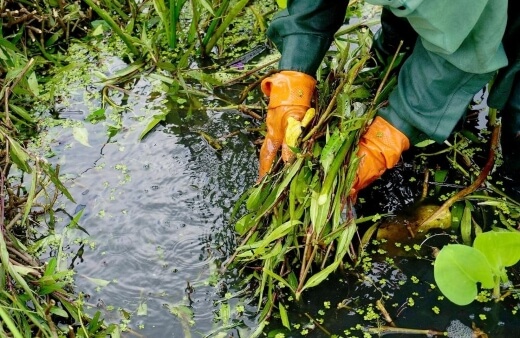
If you don’t maintain a pond, you end up with a puddle, or worse, a bog. When ponds aren’t aerated they stagnate, killing any plants, and creating in them.
You can buy pond additives which help clean the water but the best treatment is maintenance. Pond filters, oxygenating plants, and even some algae eating fish like Pleco can be a great way to keep ponds clean.
Cleaning Pond Filters
Clean pond filters annually as an absolute minimum. If you have fish, clean them every week if possible to prevent blockages and the build-up of algae.
Box filters and pressure filters are the easiest pond filters to clean as their pumps are underwater but the filters are above ground, so easy to open up, check and maintain without having to wade into the pond to retrieve the filter unit.
Maintaining Pond Plants (and Using Pond Plants as Filters)
Pond plants are natural filters, cleaning water and oxygenating ponds, but they can easily outgrow their space. In small ponds, you should aim to have around 75% of surface coverage from oxygenating plants. This creates a clean environment and provides any wildlife with shade, and shelter from predators.
If water lilies are outgrowing the pond, they are easy to divide, just pull them out of the pond, roots and all, then pull them into smaller sections and put half back in. either discard the other half or give it to a friend.
Keeping Garden Fish
Garden fish need just as much maintenance as plants and filters, with regular feeding, and pond edges needing a good scrub every couple of weeks.
In some cases, algae eaters like pleco are native species that actively help to clean ponds. They need help from a filter and running water too, but will do a lot of the work for you.
Be aware though that pleco can become territorial, so shouldn’t be kept with other fish.
Garden Pond Safety Guide

Source: bunnings.com.au
Garden ponds are the best way to get kids involved in gardening, but they are also a potential hazard. If you have young kids, place a grate over the pond so they can’t fall in, or build a small fence around the pond so they have something to lean on.
Best Garden Pond Reviews
1. Erskine Falls Natural Garden Pond

Source: waterfeaturesrus.com.au
I love these pre-built water features from Water Features R Us. Their sandblasted surface gives them a genuinely natural feel, unlike so many of the traditional black plastic liners we’re used to.
The outer shell is durable and will need a cavity digging out in the garden, but once that’s done you’ve got a ready-made pond, with a fully fitted waterfall which helps filter and aerate the water.
Pros
Cons
2. Lake Natural Garden Pond

Source: waterfeaturesrus.com.au
Lake is the largest natural style pond from Water Features R Us and comes ready to install. The generous depth means you’ll have to do a lot of digging, but it also makes it suitable for fish, who can hide away in the deeper water in summer to avoid overheating.
As with all natural look ponds from Water Features R Us, ‘Lake’ is built to last, and has several layers built-in which you can use for planting, or just for peace of mind, knowing that any small creatures that crawl in can get out again.
Pros
Cons
3. Aquascape PRO Grade EPDM Boxed 45 Mil Pond Liner

Source: amazon.com.au
If you want complete control over the size, shape and depth of your new pond you need to buy the best pond liner you can. Aquascape makes the best quality pond liners with a 20-year guarantee.
This 45mil thick sheet of pond liner is one of the thickest membranes you can buy. It’s still worth lining, either with fleece or sand to protect from any glass or rocks under your garden soil, but the flexibility you get from pond liners is unrivalled.
Pros
Cons
4. Aquapro 113L Coquetdale Preformed Poly Pond
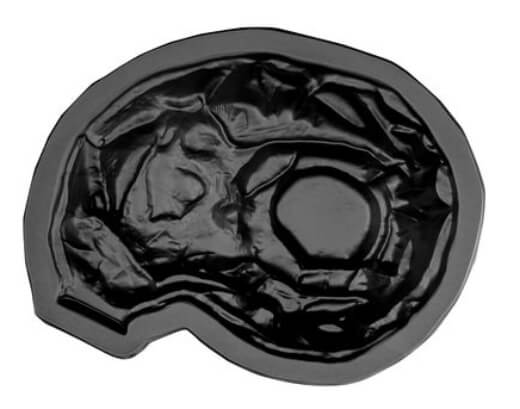
Source: bunnings.com.au
Poly Ponds were all the rage in the 90s, and they seem to be making a come-back. This small poly pond from Bunnings is built by Aquapro, one of the biggest pond suppliers in Australia, with all products manufactured in the US.
While black poly ponds will never look natural, the modern designs feature more rigid bumps and crevices for creatures to hide so they’re an easy way to bring wildlife into the garden with just one afternoon’s work.
Pros
Cons
5. Lonsdale Natural Garden Pond
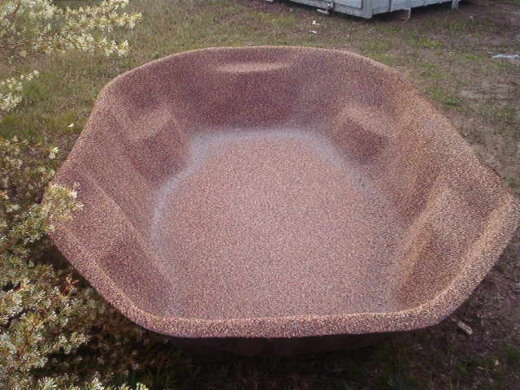
Source: waterfeaturesrus.com.au
If you’re worried about depth, you can still buy large ponds that are safe for kids and pets, with the Lonsdale natural look pond from Water Features R Us featuring five platforms for edge planting, and easy escaping if you, or a pet, ever falls in.
The sandy finish of these poly ponds makes them much more attractive than traditional black plastic poly ponds, and helps reduce the water temperature in summer.
Pros
Cons
6. Aquascape AquaGarden Pond and Waterfall Kit

Source: amazon.com.au
The above-ground waterfall by Aquascape is available on Amazon now, featuring a fully functioning waterfall that’s super easy to install.
In less than an hour, you can set up a brand new garden pond, and benefit from the multi-layered system even more by planting it up with native water plants.
If you fancy something new and don’t want to try a fire pit this summer, then this would be a perfect patio pond.
Pros
Cons
7. Aquapro 1200 Rectangular Feature Poly Pond

Source: bunnings.com.au
If you’re happier with strict neat lines, and well-manicured lawns, a rectangular pond might be the perfect fit for your garden. The simple shape makes it easy to maintain and can accommodate small fish, provided you give them shade and shelter from pond plants too.
As always, black poly ponds are never going to look natural, but if you’re looking for a more formal option and want the simple trickle or a solar water feature in the garden, this could be perfect for you.
Pros
Cons
8. Aquapro 910 Round Feature Poly Pond
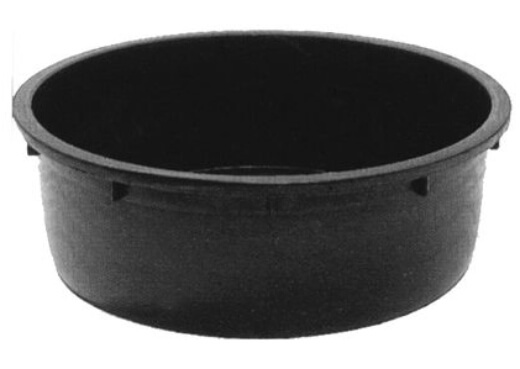
Source: bunnings.com.au
These super sturdy round ponds by Aquapro might not look like much, but they give you so many options. You could bury this garden pond liner really quickly into the garden for an instant pond, ready for wildlife, with a few stones so birds can drink and climb in and out of the water to wash.
But, if you fancy something even simpler, you could just place this directly on the patio and build up stones around the edge to create a raised pond, and even plant into the stone in a 70s rockery style so you don’t notice the plastic sides at all.
Pros
Cons
9. Aquapro 100L Small Rock Look Pond
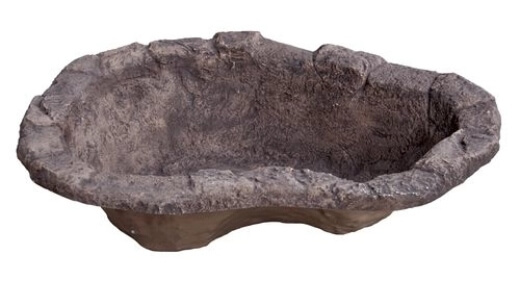
Source: bunnings.com.au
To get the full effect from the Aquapro rock look pond, you’ll need a few added extras, to create a simple but effective waterfall in the corner of your garden.
The simple mud-coloured design blends well into the garden and is a useful alternative for anyone worried about pond liner sheets. The only downside is that you don’t have the ability to adapt your own design.
Pros
Cons
10. Hygger Pond Liner 500D PVC Soft Rubber New Material
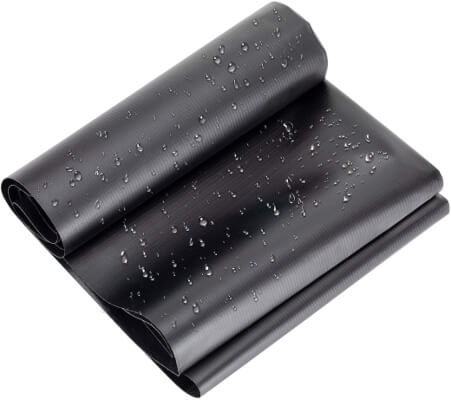
Source: amazon.com.au
If you’re planning to build your own garden pond from scratch, invest in a really good quality pond liner. You can cut corners and save a ton of money using a pond liner like this if you’ve got clay soil that drains slowly, but don’t take the risk if you can afford not to.
In my experience, cheap pond liners like this work well, but they are a risk. When we moved into our first house we got a quick, cheap, pond liner like this, and installed it quickly. It’s lasted for over ten years now, but we prepared the ground first and lined it with fleece too.
If you’re looking for money saving options, these are great but don’t cut corners if you don’t have to.
Pros
Cons
Garden Pond Top Picks for 2024
Garden Pond - Our Top Pick


Source: waterfeaturesrus.com.au
I love the natural look ponds from Water Features R Us. The company features a lot in our reviews, but that’s because they make excellent products that truly last a lifetime.
Poly ponds went massively out of fashion at the start of the century, with a distaste for plastic stemming from its clumsy visuals, as well as its lack of environmental credentials, but these ponds last a lifetime and look beautiful. Best of all, they’re an easy to install home for wildlife.
Premium Choice Garden Pond


Source: waterfeaturesrus.com.au
The clumsily curved edge of the Lake design from Water Features R Us is a thing of beauty. This pond takes just hours to install, can easily accommodate a waterfall or a fountain, and is brilliant for fish, but really, its appeal is in how effortlessly natural it looks.
If you’re trying to build a garden that blends seamlessly back into nature and gives homes to native flora and fauna, then this is 100% the pond for you.
Best Value Garden Pond


Source: amazon.com.au
No cast pond liner is ever going to beat a fabric pond liner sheet for value. Pond liners, despite there being a huge disparity between each brand, thickness, lifespan, etc. are relatively easy to assess value: check for size and the length of warranty.
No pond liner manufacturer gives false warranties, because their products rely on reliable warranties and user satisfaction. Always check the length of the warranty for a gauge of how good a pond liner will be. 15-20 years is usually a good sign.
Best Garden Pond Installers in Australia
Pond installers are easy to come by in Australia, but what should you be looking for when choosing the best pond installer near you? Depending on the style of pond you choose, you’ll either need a plumber, a landscaper, or maybe even an irrigation installer to get your new pond set up.
Any ponds with running water more complicated than basic filters or pumps need a qualified plumber to install. Pond plumbers are harder to find, as it’s a specialist trade, but they’ll build ponds that are unbeatable.
Brisbane Garden Pond Installer
Fish Pond Service specialise in pond maintenance and can get your new pond in Brisbane set up and ready to go in no time. Reach Fish Pond Service here.
Perth Garden Pond Installer
Revive Landscaping is one of the best landscaping companies in Perth, with a great track record. They provide a specialist pond and water feature installation service for Perth and the surrounding areas. Learn more about Revive Landscaping here.
Sydney Garden Pond Installer
Pondman is a family-owned business in Sydney, with years of expertise in building and maintaining running-water ponds, from fish ponds to waterfalls. Contact Pondman here.
Melbourne Garden Pond Installer
It’s easy to find pond maintenance experts in Melbourne, but there’s only a handful of good pond installers. Pond Wise are Melbourne’s top pond installer, and is always on hand to follow up and check out any issues after installation too. Know more about Pond Wise here.
Benefits of a Backyard Garden Pond
Environmental Benefits

A backyard garden pond impacts the environment in many ways. In fact, adding an expanse of water (of any size) to your outdoor space is one the greatest things you can do for the planet we call home...
- Provides a safe haven for wildlife: As we experience more and more urbanisation the natural habitat for many species is being reduced dramatically.
Installing a pond in your garden helps address this, and will soon become a relied upon resource for a plethora of wildlife.
Birds will drink and preen, insects will thrive, amphibians will make it their home, mammals will discover a welcoming watering hole…
Ponds attract so much life, thanks to offering life-giving water, food, a sheltered breeding ground, bathing spots and more – not to mention providing you with a wonderful location in which to observe Mother Nature at her finest.
- Provides a healthy ecosystem: The moisture from a pond will leech into the surrounding soil, providing water to nearby plants and grasses.
In general, established backyard garden pond don’t need to be filled up with water (although this might not be wholly accurate during a hot Aussie summer), as rainfall will naturally filter through and keep levels high.
This allows the water to naturally stabilise into its own self-sustaining ecosystem, benefiting the wildlife who make it their home and the plant life that surrounds it.
- Reduces environmental pollutants: It does this by taking up an area of yard that would otherwise probably be covered in lawn. This negates the need for mowing and caring for an area of grass.
This, in turn, decreases pollutants expelled by a lawnmower (in the case of petrol models), reduces the use of electricity (if you have a corded mower) and removes the need to use pesticides and fertilisers for said lawn.
The use of these, while making for a bowling green-esque area of grass, has the disadvantage of creating toxic runoff from rainwater that then ends up in the water supply.
In addition, a pond creates sludge that’s then trapped in the filter. This is a great natural fertiliser that can be used on other areas of the garden environment.
- Creates a location conducive to native plants: The area around your pond can be planted with native plant life. This provides the most natural environment for the local wildlife that’s attracted to the water.
This is vital, especially in suburban areas, as more and more natural habitats are destroyed to make way for houses, roads and industrial areas.
Aesthetic Benefits

No-one can deny that ponds are great to look at! Not only do they provide visual benefits, but those that are auditory too.
- Adds a great focal point: From watching the ripples on the water to spotting fish as they dart beneath the surface, backyard garden pond, quite simply, look wonderful.
You might want to consider adding features, such as waterfalls, rock borders or statues, and plants.
Lilies and reeds not only make a pond even more visually appealing, but the wildlife will appreciate the shade and shelter they provide. You can also add Fornight lilies or Dietes grandiflora to the mix.
- Create your own private Zen zone: The sound of water is unmistakable – simply close your eyes and enjoy the hypnotic babble created as the water filters or spills over a water feature.
It’s like having your own private therapy session (and it’s cheaper) – the calming effects of the sound of water are nothing short of amazing.
You can also use this to drown out other noise. This might be traffic, noisy neighbours or something else, but it can be pretty effective.
A pond helps create white noise (think a fountain or waterfall) that masks other sounds. It’s even more effective if you build a backdrop that reflects the echo of the water in the direction of the source of the unwanted noise.
Health Benefits

Anything that has a positive effect on health has to be a good thing, right? So let’s talk about how a simple backyard pond can have far reaching benefits – particularly for your mental health.
- It provides sanctuary: In our 24/7 world – and especially for the ever-increasing number of people who carry out some element of their job from home – having a calming place of sanctuary isn’t just nice to have, it’s an absolute necessity.
We talked about the calming effects of water above, and a pond creates an area where you can sit and escape the frenetic buzz of the world at large.
- Reduces stress and anxiety: Water releases negative ions into the air that surrounds it. These are believed to help the uptake of serotonin within the brain, an important function of human physiology that significantly helps us cope with and reduce stress and anxiety.
The negative ions also help purify the air, combat allergens and germs, which in turn has a positive effect on the overall health of the body.
- Improves physical health: While ponds are relatively simple to keep in good health, they do require some element of physical effort to look after.
Tending plants, feeding fish, cleaning the filters, weeding etc all promote the activity necessary to remain in good shape.
Educational Benefits

Kids and adults alike can learn much from having a pond – and it’s good fun too.
- Discover more about the natural world: Watching the wildlife as it thrives in and around a pond creates a real connection between humans and nature.
It’s one thing to read about our relationship with the natural world – but quite another thing to watch it playing out in front of your eyes.
The whole aspect of planning, building and tending a pond increases awareness of how ecosystems work. In turn, this intensifies awareness of our place within the environment and the impact our actions have upon it.
- Increases our environmental responsibilities: Watching our own little piece of nature is likely to stimulate a more intense desire to be environmentally responsible in other areas.
Children benefit from growing up with this ethos, helping to instill a mindset that creates a better future for our planet.
Financial Benefits
You might not think that having a pond brings with it any financial benefits, but you’d be wrong…
- Reduces energy needs: Air is naturally cooler around water, and in the hot Aussie climate this means that you’ll have a more pleasant environment in which to sit when the mercury climbs.
This in turn can lead to being outside more, and the resulting less use of air conditioning and fans in the house, therefore lowering your energy consumption.
- Conserves water: Because the area around a pond is naturally watered, there’s less need to use additional H2O to water plants and lawns.
Clever positioning of drain pipes can direct water runoff into the pond itself, so providing a natural reservoir (and reducing the need to top up a pond in the dry season).
You can also use water from the pond for other plants in the backyard.
- Can add value to your property: Ponds are highly prized, and while having one in the yard might not add dollars to the price tag, it can definitely add to the wow factor.
And that is exactly what you need to increase the desirability of a property. Sure, you might not be thinking of selling right now.
But in the future? Well, who knows…?
5 Things to Consider Before Putting a Pond in Your Garden
Ponds can be a wonderful addition to any garden – they attract wildlife, and offer a platform for a fantastic range of beautiful plants. But before you grab your shovel, hold on just a second: there are a few things you should consider first to ensure that your pond is the very best it can be.
1. Make it Safe
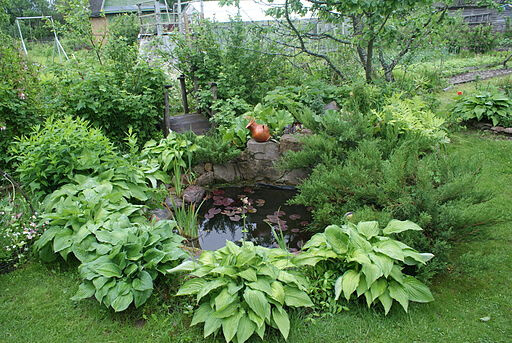
Safety is paramount where ponds are concerned, and it’s definitely something you should bear in mind as you plan yours. The good news is, that if you consider safety features as you’re putting your pond together, you may have more options available to you than if you have to adapt your pond later on.
“Either way, the most important aspect is that the fence is solid, and impenetrable. Children can be very clever when it comes to problem solving!”
Other tips include creating sloping edges, installing a pool alarm and putting in a wire mesh top – check the post to find out more.
2. Choose a Suitable Location
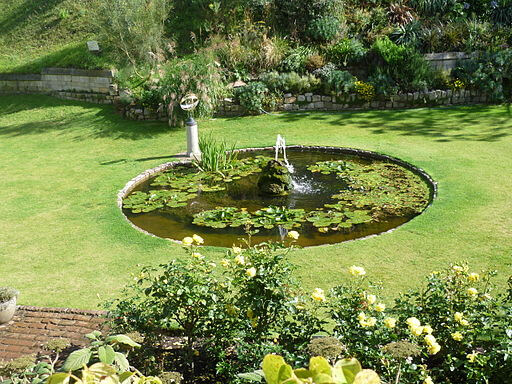
If at all possible, choose a spot that is sunny, level, and away from trees. This will allow your plants to thrive, and mean that the amount of leaves you need to clear away each autumn is significantly reduced.
See our list of the best water plants you can grow in Australia.
Also, try to find a spot that is visible from inside your house – both for the safety of children, and so that you can enjoy looking at your creation when you’re indoors.
3. Include Multiple Levels
Many green fingered types want to install a pond in order to attract wildlife to their garden, as the water can attract lots of different types of insects and animals that may never venture into your yard otherwise.
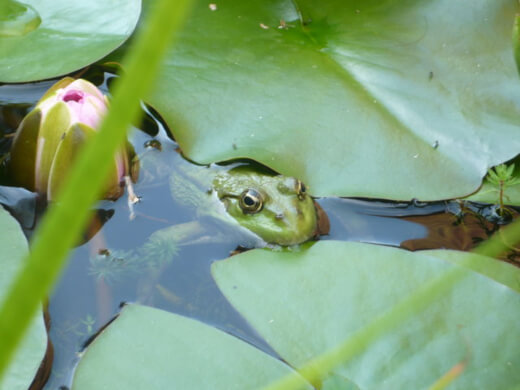
To make your pond really attractive to wildlife, though, you should plan it carefully and include useful features, such as a range of levels.
As Jeremy Biggs at The Garden Pond Blog explains, “Most garden ponds don’t have enough shallow water. The greatest variety (of) wildlife in ponds lives in the very shallow water and tadpoles, newt larvae, water beetles, dragonflies: all love these really shallow areas.
A planting shelf that you see on many pre-formed liners is, as far as wildlife is concerned, deep water! “Make as much shallow water as you can for the best wildlife ponds.”
4. Don't Use Invasive Plants
Certain species of plant are liable to take over your pond completely, and destroy the other plants that live there.
Avoid introducing the following plants to your pond:
- Canadian waterweed Elodea canadensis
- Carolina water-shield/fanwort Cabomba caroliniana
- Caulerpa taxifolia and Caulerpa racemosa (marine algae/seaweed)
- Creeping water-primrose Ludwigia peploides
- Curly waterweed Lagarosiphon major (Elodea crispa)
- Duck potato Sagittaria latifolia
- Fallopia japonica x Fallopia sachalinensis
- False Hampshire-purslane Ludwigia x kentiana
- Few-flowered leek Allium paradoxum
- Floating pennywort Hydrocotyle ranunculoides
- Giant hogweed Heracleum mantegazzianum
- Giant knotweed Fallopia sachalinensis
- Hottentot fig Carpobrotus edulis
5. Decide What You Want from Your Pond
Keeping an open mind can be great when gardening, as you can adapt your yard as inspiration strikes. But when installing a pond, it’s good to have a rough idea of what you’re hoping to achieve at the beginning, so that you can incorporate the necessary elements as you plan the area.
It is also essential to design the pond's plumbing system which is what our pond plumbing guide will teach you.
- Do you want to attract wildlife?
- Would you like to keep koi carp in the pond?
- Are you hoping for a waterfall feature?
Getting an idea for how you want your pond to look will enable you to make decisions early on about the design of your pond, especially key elements which can have an impact later on down the line, like size and location.
Tips for Growing a Garden Around Water
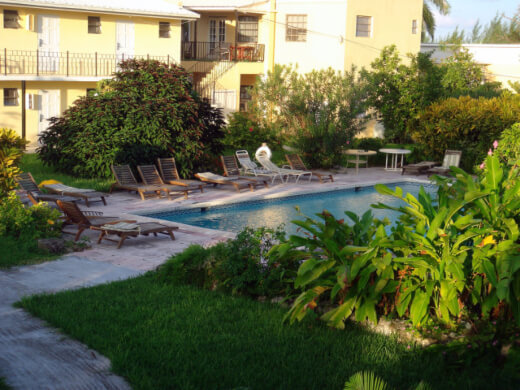
If your outdoor space includes water, there are some special things you should be aware of. Follow the tips below for growing a garden in or around water.
Growing a Garden Around Pools
Pools are an excellent way to relax during warmer months, but growing a garden around them presents special challenges.
Because of the chlorination – or salt content depending upon pool type – and the upkeep associated with a healthy pool, selecting your plants and gardening techniques carefully is essential.
- Select Heat-Resistant Plants. Pools reflect light and heat; that’s why you get such a great tan lying next to one or in one. This means that any nearby plants will also be subject to extra light and heat.
Select weather-resistant plants that can hold their own under extreme conditions. - Choose Plants That Are Tidy. Keeping a pool clean is a daily battle. From emptying and caring for the filter to physically cleaning the pool itself, upkeep requires work — this is why many opt for pool enclosures.
Be sure to look for options that don’t drop leaves or flowers so you don’t spend an excessive amount of time cleaning out your pool. - Use Containers. While your pool water may seem contained, if people swim in it, there will be splashing. Sure, that splashing might seem harmless, but if the ground around your garden becomes saturated with chemicals from the water, the plants are likely to suffer. Use containers to create a level of separation.
Garden Around Fountains
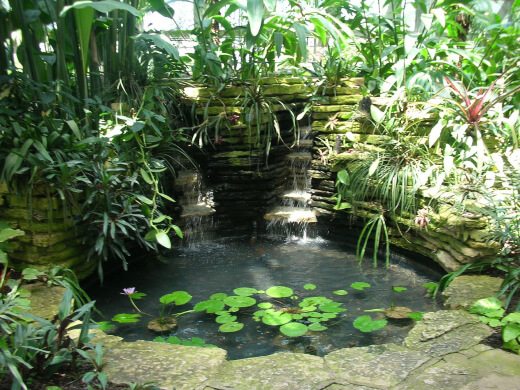
Much like pools, fountains are manmade structures that add beauty to your backyard. Unlike pools, they don’t contain chemicals. However, there are special considerations for gardens in and around fountains.
- Consider Water Plants. Plants like lily-pads create a sense of beauty and wonder that are only possible in chemical-free water. Use a little creativity to spice up your fountain.
- Add Fragrance. Love sitting near your fountain to relax? Does the sound of the water sooth you? Why not add an additional level of enjoyment with fragrant flowers and plants?
Go for a mix of beauty and scent with fragrant plants like lavender that promote relaxation. - Take Advantage of Your Lawn. Just because you have a fountain doesn’t mean you can’t plant up to its edge. While it’s pleasant to have a walking path to your backyard fountain, it also requires upkeep.
Instead, by growing your lawn up to its edge, you can enhance its appearance without additional work.
Tips for Garden Around Ponds
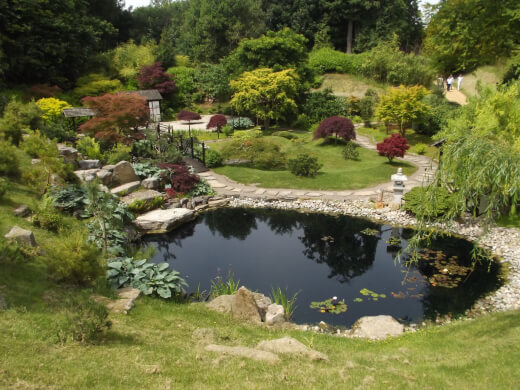
Whether your pond is natural or man-made, it can be an aesthetically pleasing aspect of your backyard. Consider the following planting tips for its surrounding garden.
- Use Compost or Fertiliser. Unlike a backyard pool or fountain, ponds are meant to appear natural. This means that you’ll want to hide any liners or unsightly edges.
Using compost or fertiliser up to the edge helps camouflage any eyesores and promotes the health of surrounding plants. - Add Visually Appealing Grasses. Landscaping grasses add visual appeal without the work. Because of their height, they can disguise pond edges, leading to a natural flow.
They can also provide needed food and refuge for wildlife around your pond and any fish or frogs living in your pond. - Pay Attention to Your Pond’s Inhabitants. While a plant may have beautiful flowers or an appealing aroma, it might be deadly for fish and frogs that call your pond home.
To maintain safety, do research upfront and avoid any plants that may be harmful to your pond’s inhabitants.
Water can be a visually appealing feature of your backyard, whether it’s in the form or a pool, a fountain, a pond or something else entirely. Follow the tips above and think about how you’d like to enhance your outdoor space during the next growing season.
Dealing with Pond Algae
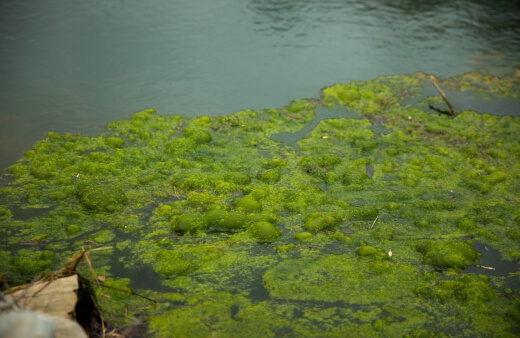
Pond algae is a common complaint among pond-owners, and whilst green sludge is the stuff of nightmares, a totally algae-free pond will always be a pipedream.
Because the truth is, there’s no such thing as an algae-free pond. That’s because algae occurs naturally in water and it’s actually essential for a healthy and ecologically balanced pond.
But whilst every pond will have some algae growing in it, it doesn’t mean that you have to settle for dark, thick and unsightly garden water features.
With regular maintenance and attention, pond algae can be kept under control and to a minimum. If you prefer clean to green, there are some basic algae facts that you should know which will help with maintenance and planning.
Perhaps the most important thing to understand about controlling the growth of algae is why it grows. Once you understand what type of environment is conducive to the growth of algae, it will be much easier to know what to do in order to control it.
Basically, algae needs light and nutrients (nitrates and phosphate) to thrive. It loves a pond where there’s debris at the bottom which results in loads of nutrients.
It also loves food, so it’s particularly happy when your fish are being over-fed or your water lilies are getting a bit too much fertiliser. It likes shallow water where the temperatures are warmer and it loves flat surfaces.
Most of all, algae likes it when the complex system in your pond is imbalanced, so to keep the green stuff in abeyance, the trick is to do the things that restore equilibrium.
What Algae Likes and What to do About it
Don’t overfeed fish or overstock your pond with fish as their excrement may be resulting in excess nutrients. Some experts even recommend reducing fish food during an algal bloom to force the fish to eat algae instead of their regular food.
Check the run-off from gardens, lawns and even aquatic plants to make sure that fertilisers and chemicals aren’t ending up in your pond.
Sunlight
Increasing coverage of the pond’s surface area with floating plants and water lilies will decrease the amount of sunlight available to pond algae.
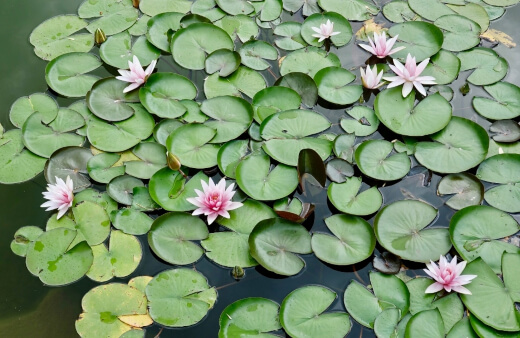
Warmth
Algae will grow rapidly in a small, shallow pond where the water heats up quickly. Again, lots of lilies and aquatic plants will help shade the water and keep the temperature down.
However, you will notice that algae is generally at its worst in spring when water temperatures are on the rise, the sun is warmer and the plants haven’t started their new season growth.
Oxygen
Excessive surface vegetation can also result in too little oxygen in the water however, and this is detrimental to the growth of algae-eaters such as fish, aquatic snails and tadpoles.
As you can see, keeping a pond healthy is all about balancing the ecosystem and keeping algae to a minimum does require an understanding hand.
But there are some types of algae that don’t need to be treated with any compassion – such as floating and string algae – which are also generally more of a problem during seasonal changes.
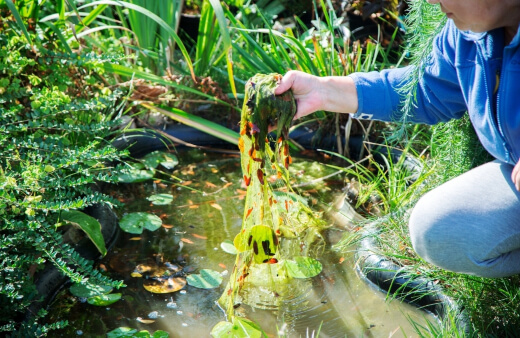
Getting rid of string algae requires some manual labour, and is best removed by twirling it around a stick or special pond wand. There are also many handy pond supplies on the market which are very helpful in keeping algae to a minimum.
For example, an aerator will oxygenate the water whilst a vacuum can remove organic waste or sludge from the bottom of the pond, thereby preventing algae.
Also see: Dam and Pond Aeration Guide
Minimising Algae in Your Pond
Having some algae in your pond or water feature is a good thing – but having pea soup clearly isn’t. Knowing what causes algal growth and how to minimise it will go a long way towards making the life of a pond owner stress-free.
Remember, like any plant, algae needs food and light in order to photosynthesise and grow and therefore to control it, a number of factors need to be considered.
Excess algae is generally more of a problem in new ponds because the ecological balance between plant and animal life hasn’t yet been established and there are no natural predators which would normally keep algal growth under control.
It goes without saying that regular maintenance, monitoring and management of your pond is important for algae control but let’s look at the most common causes of algae problems and what can be done to minimise them.

High Levels of Light
Abundant sunlight accelerates the growth of algae, so when designing and building a pond, the long-term aim should be to starve algae of light. A dark colour on the pond’s interior is also important.
Other things that reduce sunlight (and therefore reduce the ability of algae to thrive) include shade from nearby trees, shrubs and walls and of course, cover from aquatic plants.
At the outset of your pond construction you should determine a location that is in the shade or receives very little sunshine. It’s the ultraviolet rays that help photosynthesise the chlorophyll in algae allowing them to grow.
Take the sunshine away and this will greatly reduce the growth rate. To remove the sunlight in a hurry, you can instantly cover the pond with a high-UV resistant shade cloth suspended over the pond.
Building a pergola and covering it with shade cloth or UV-resistant polymers may be a better long-term fix. If the pond is small enough, you could transform the area by providing some large foliage plants that will provide dappled shade for the pond’s surface and make an almost instant fix.
High Water Temperatures
Again, good pond design (steep sides, deep water) will mean the larger volume of water will take longer to warm up, thereby slowing down the growth of algae.
In other words, you need to maximise the pond’s volume relative to its surface area and remember, excess algae is more likely to be worse in the warmer months.
Pollutants in the Pond Water
Excess algae could also be caused by an excess of nutrients in the water. Check that run-off from your garden or lawn or even from rain which could contain soil particles, fertiliser or chemicals isn’t going into your pond and feeding the algae.
It’s important to regularly remove excess leaves and decomposing organic debris from your pond in order to take away this source of nutrients for the algae.
Plant/Fish Imbalance
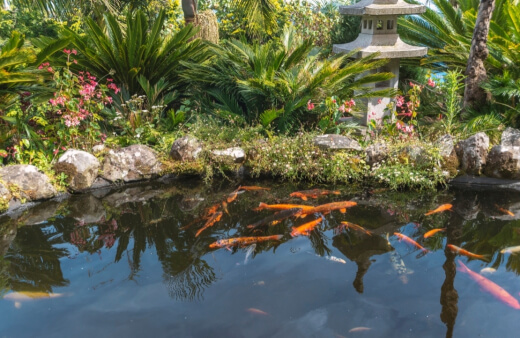
Having the right types and amounts of plants in the pond is important, as these absorb nutrients for themselves and therefore starve the algae of its food source.
A pond should have around two thirds of its surface covered by plants (e.g. water lilies) in order to reduce sunlight and lower the temperature of the water.
Algae also feeds on fish waste and fish food, so it’s important not to overstock your pond.
Poor Water Circulation
Installing the right pond equipment is vital in order to pond algae control. Algae loves stagnant conditions, so it is important to keep the water moving with pond supplies like pumps and filters.
Chemical treatments can also be used to minimise algae, and the first step should be testing your water to identify deficiencies (e.g. wrong pH levels) and then getting the appropriate product to fix it.
However, there are many different products on the market and it is important to discuss your needs with experts who specialise in creating, managing and enhancing aquatic environments.
Water treatment products are also very helpful, to help control all biological problems from algae to harmful sludge. Algae is a reality, but there are many things that pond owners can do to create a stable pond environment and reduce the prevalence of outbreaks.
Increase the Filtration
This is another easy fix that can be solved within a weekend. Obviously it depends on how large your pond is but it can usually be overcome simply by adding a pump and fountain to the mix. This will help oxygenate the water, halting the stagnation process which algae require to grow.
Running water is another option recycling the pond’s water through a filter system but this will take a little longer to set up. However, it will provide much better long-term solutions.Another option is to increase your aquatic plants.
Reeds on the banks of your pond will help take away some of the residual nutrients and adequately control your pond algae plus they will help filter the water and oxygenate your pond.
Reduce the Nutrients
The main source of nutrients comes from over-feeding pond fish. Leftover debris from fish feed is high in nitrogen and phosphorus, nutrients that pond algae needs to grow. Therefore, only feed your fish as much as they need and don’t become tempted to oversupply.
Introducing frogs and other aquatic life to your pond will also help reduce nutrient debris – this can come from rotting leaves as well. Increasing your plant life around the edge of your pond will give them some better places to reside and they will help control pond algae naturally.
Author Bio
Brett McCormack is the Aquascape Supplies account manager for Vic, Tas, SA and WA. Aquascape Supplies are Australia’s source for pond equipment.
We offer professional advice from experienced pond designers and builders and can assist you with the right equipment for your project. Get in touch with our experts for advice on pond liners, pond pumps, water features and more.
As you can see, there are many benefits to having a backyard garden pond. Before deciding to have one, make sure to know what to consider before putting a backyard garden pond.
It may seem that there is lots to think about when planning a pond, but once you’ve got started you’re likely to be so excited and caught up with inspiration that it will seem much more like fun than work.
The key to the highest level of enjoyment is to take good advice, purchase good quality elements and to look after it in the correct manner.
Aquascapes Supplies Australia, are your one-stop-shop location for everything and anything to do with backyard ponds.
With years of experience and a professional, approachable team, Australian residents need look no further for all of their backyard garden pond needs.
Wrapping Up Our Garden Pond Guide
Garden ponds are a crucial part of any wildlife garden but can be forgotten in suburban gardens. Even when wildlife isn’t a consideration in your garden, the calming openness that water provides isn’t replicable in beds and borders.
Building the best garden pond you can afford is the single biggest step you’ll take to feeling like your garden is finished, but also, that you’ve put your stamp on your patch of land.

Published on May 23, 2022 by Gary Clarke
Last Updated on January 11, 2024


